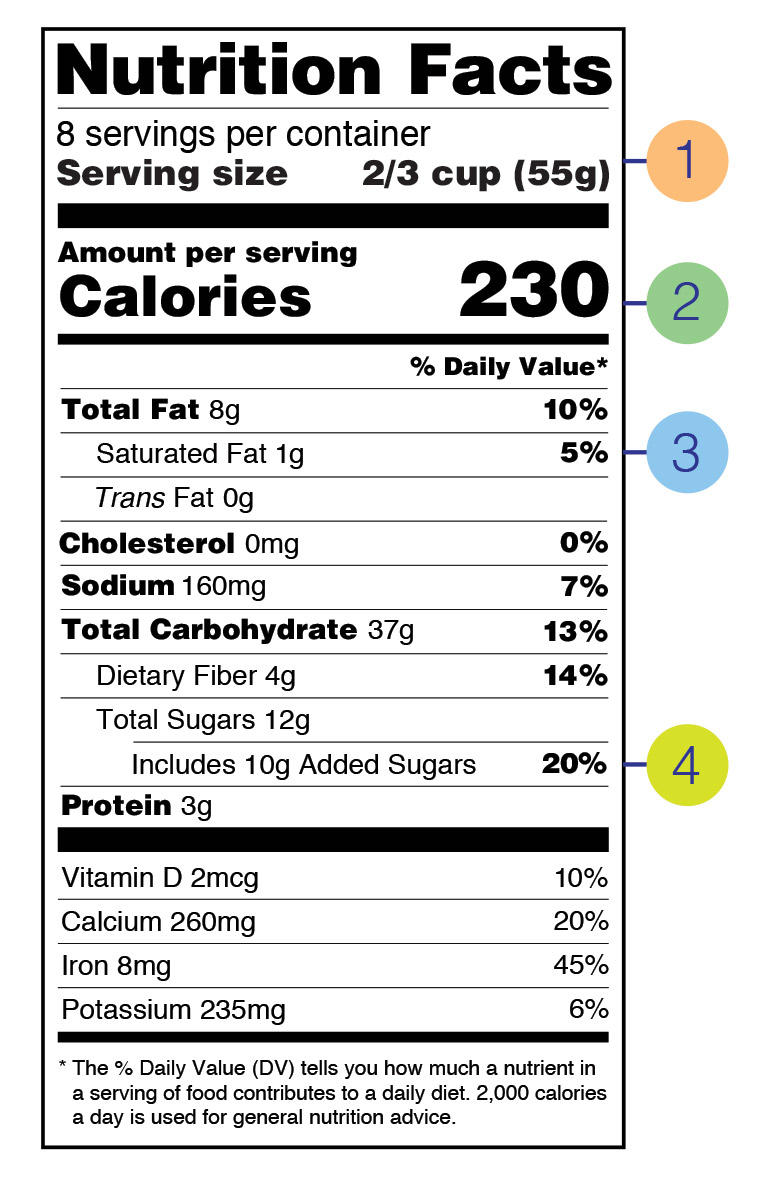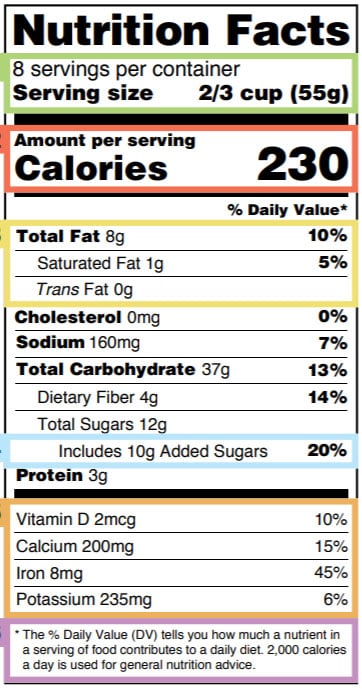38 daily value on food labels
What's New with the Nutrition Facts Label | FDA Daily Values for nutrients have been updated, which may make the percent Daily Value higher or lower on the new Nutrition Facts label. As a general guide: 5% DV or less of a nutrient per serving ... Daily Value on the New Nutrition and Supplement Facts Labels << The Lows and Highs of Percent Daily Value on the New Nutrition Facts Label. The Nutrition Facts label on packaged foods and drinks has been updated to make it easier for you to make informed ...
Added Sugars on the New Nutrition Facts Label | FDA The Dietary Guidelines for Americans recommends limiting calories from added sugars to less than 10 percent of total calories per day. For example, if you consume a 2,000 calorie daily diet, that ...

Daily value on food labels
Food Labels | CDC Understanding the Nutrition Facts label on food items can help you make healthier choices. The label breaks down the amount of calories, carbs, fat, fiber, protein, and vitamins per serving of the food, making it easier to compare the nutrition of similar products. ... Keep in mind that the % Daily Value of each nutrient, such as total fat of ... How to Understand and Use the Nutrition Facts Label | FDA Overview. The information in the main or top section (see #1-4) of the sample nutrition label (below) can vary with each food and beverage product; it contains product-specific information ... Percent daily value - Canada.ca About percent daily value. The % DV is found on the right-hand side of a nutrition facts table. It is a guide to help you make informed food choices. It shows you if the serving size has a little or a lot of a nutrient: 5% DV or less is a little. 15% DV or more is a lot. This applies to all nutrients with a % DV.
Daily value on food labels. How To Read Food and Beverage Labels | National Institute on Aging At the top of the Nutrition Facts label, you will find the total number of servings in the container and the food or beverage's serving size. The serving size on the label is based on the amount of food that people may typically eat at one time and is not a recommendation of how much to eat. Read more about serving and portion sizes. The Lows and Highs of Percent Daily Value on the Label The percent Daily Value (%DV) shows how much a nutrient in a serving of food contributes to a total daily diet. The %DV can help you determine if a serving of food is high or low in a nutrient ... EOF Daily Value: Definition and How to Calculate It - Insider Divide the amount of a nutrient in a food by the value determined in the above formula. Multiply that number by 100 to convert to a percentage. For example: Let's say you follow a 1,500 calorie diet and have determined that your daily value for protein is 37.5 grams. If you eat a serving of peanut butter with 8 grams of protein per serving and ...
What is Percent Daily Value (% DV) on Food Labels? - NKFH In 2016, the Food and Drug Administration revised the Nutrition Facts label to list % DV for added sugars, which is 50 grams, or about 12 teaspoons of sugar per ... Percent Daily Value On Food Label - LabelCal What are Percent Daily Values on Food Labels? Percent daily values represent the percentage of the recommended daily intake a single serving of food contains. For instance, if the percent daily value for saturated fat is 45%, that means you are getting almost half of the saturated fat that the FDA recommends you consume in one day. Food labels - NHS Nutrition labels are often displayed as a panel or grid on the back or side of packaging. This type of label includes information on energy (kJ/kcal), fat, ... What Does "% Daily Value" Mean on a Food or Supplement Label? The 100% Daily Value is more than what most people consume. The 100% Daily Value amount is a goal, an encouragement to increase the intake of each of these nutrients. Nutrients to limit: These are total fat, saturated fat, trans fat, cholesterol, and sodium. For these nutrients, the 100% DV is an approximate upper limit of safe consumption.
How to Calculate % of Daily Value on Food Labels | livestrong People often say they want to eat healthier. One of the first steps to take is examining nutritional value prior to purchasing foods. Food labels include most relevant information, including calories, fat, protein, and carbohydrate content. Vitamin and mineral levels are also included. Table of Daily Values - Canada.ca Overview. This document is a two-part table that sets out the recommended amounts of nutrients (the daily value) for specific age groups. These are the reference points upon which the % daily value in the nutrition facts table are based. Part 1 of the table sets out the daily values for macronutrients and sodium for two age groups. How you can Calculate % of Daily Value on Food Labels The Daily Values have been updated, which may make the percent Daily Value higher or lower on the new Nutrition Facts label. Visit Daily Value and Percent Daily Value on the New Nutrition and.Divide the amount of a nutrient in the food by the recommended amount; then multiply by 100 to convert to a percentage. The Basics of the Nutrition Facts Label 4 Mar 2022 — Use the percent Daily Values (DV) to help evaluate how a particular food fits into your daily meal plan. Percent DV are for the entire day, not ...
How To Calculate Percent Daily Value for Food Portions The Percent Daily Value is calculated by dividing the amount in a serving by the total recommended daily amount. Multiply that answer by 100, and you've got your %DV! For example: 3g in a serving. 15g recommended per day. 3/15 = 0.2. 0.2 x 100 = 20%.
Daily Values (DVs) - National Institutes of Health Daily Values. Recommended intakes of nutrients vary by age and sex and are known as Recommended Dietary Allowances (RDAs) and Adequate Intakes (AIs). However, one value for each nutrient, known as the Daily Value (DV), is selected for the labels of dietary supplements and foods. A DV is often, but not always, similar to one's RDA or AI for ...
Interactive Nutrition Facts Label The Daily Values are reference amounts (in grams, milligrams, or micrograms) of nutrients to consume or not to exceed each day. For example, the Daily Value for saturated fat is less than 20 grams (g) per day (based on a 2,000 calorie daily diet), which equals 100% DV. If the Nutrition Facts label says one serving of a food contains 1.5 g of ...
Your Guide to the New Food Label | National Kidney Foundation The Nutrition Facts Label helps you understand the nutrients a food product contains, and the Nutrition Facts Table lists all the items required by the law. Food labels have percent daily values listed for a set group of nutrients based on the Food and Drug Administration (FDA) recommended 2000 calorie diet.
Nutrition Labelling - Table of Daily Values - Canada.ca Food intended for children one year of age or older but less than four years of age or for children four years of age or older and adults. 1. Fat. 44 g. 75 g. 2. Sum of saturated fatty acids and trans fatty acids. 10 g. 20 g.
Percent daily value - Canada.ca About percent daily value. The % DV is found on the right-hand side of a nutrition facts table. It is a guide to help you make informed food choices. It shows you if the serving size has a little or a lot of a nutrient: 5% DV or less is a little. 15% DV or more is a lot. This applies to all nutrients with a % DV.
How to Understand and Use the Nutrition Facts Label | FDA Overview. The information in the main or top section (see #1-4) of the sample nutrition label (below) can vary with each food and beverage product; it contains product-specific information ...
Food Labels | CDC Understanding the Nutrition Facts label on food items can help you make healthier choices. The label breaks down the amount of calories, carbs, fat, fiber, protein, and vitamins per serving of the food, making it easier to compare the nutrition of similar products. ... Keep in mind that the % Daily Value of each nutrient, such as total fat of ...





Post a Comment for "38 daily value on food labels"